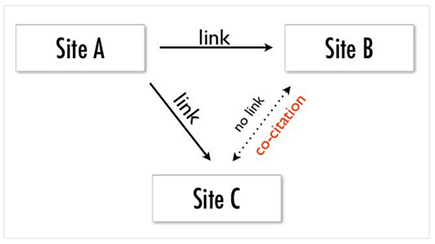
In its bid to provide better services to legitimate online users, Google introduced several algorithm changes and updates geared towards combating spam and other poor-quality content. These updates also placed lesser importance on the power and influence of links on ranking, putting greater importance on the context and words using these links.
It was during these times when “co-occurrence” and “co-citation” became hot topics in the SEO community, with some calling these phenomena “the next big thing in SEO”. Other experts even point to these concepts as the basis for future algorithm updates which will forever change the face of search as we know it.
But what is co-citation anyway, and how is it important to Search Engine Optimization?
To understand co-citation, you must first dispel from your psyche the traditional notion of link building. Traditional link-building makes use of anchor texts and the use of embedded links – an SEO technique abused by black-hat practitioners – while co-citation can be likened to link building without necessarily using actual outgoing links.
Sounds unlikely or uncanny?
The concept relies on Google’s greater focus on the relationship of webpages as a more important ranking factor instead of focusing merely on actual links. The following discussions will help you understand co-citation better in a bid of helping you understand the ever-evolving SEO game.
Understanding Co-Citation and Co-Occurrence
Co-citation and co-occurrence are often used interchangeably with some pointing at these concepts as basically one and the same. There are however subtle differences between the two, an understanding of which would give you greater insights in using these concepts for SEO.
Let’s start with co-occurrence.
Co-occurrence basically focuses on similar keywords that occur between different websites. Similar here does not necessarily mean identically the same set of keywords, but rather keywords that are relevant to each other topically and according to context.
Understanding this concept is very important, now that search engines have shifted towards the semantic web as well as expanded indexation ranking updates to search algorithms like the one introduced in Google Caffeine. In these changes, focus has shifted less from keywords and more into the context and meaning behind the words – closer to the intent of the search user.
Co-citation on the other hand occurs when a brand or a website is mentioned or cited by two independent and basically different sources that are not physically linked with each other. In this concept, the connection between sites rely not only on the links that physically bridge their realms but through their content.
When the cited brand or website is mentioned in these sources (better if the source website is authoritative) even without the embedded links and as long as these websites discuss the same topics. In order to have co-citation, there should be co-occurrence – so these two concepts have to work together for better SEO.
Co-Citation and Conventional Linking
Link building is still important as a ranking factor but the focus and importance has shifted away from the conventional concepts of link building. Actual embedded links is still important but it would have greater impact on SEO if used in an interplay with co-citation.
A great way to describe this concept was presented Jayson DeMers of AudienceBloom, providing an illustrative demonstration of how co-citation and actual link building should go hand-in-hand. In his sample, he illustrated how the two websites “Site A” and “Site B” developed a connection or a co-citation relationship even with the use of physical links.

A variation of this co-citation relationship can also occur if two unlinked websites make a connection with an authoritative site, described as “Site A” in the graphical example below. It can get more complex as you try to understand the relationships between multiple sites, but basically the concepts presented here about co-citation can give you greater insights on how to use this for SEO.

Key Principles of Co-Citation for SEO
To have a better understanding of co-citation and how it can be used for SEO, it would be best to gain some insights on key principles inherent in this concept. Adam Stetzer from Search Engine Watch shared a good list of these principles in his article “What is SEO Co-Citation”.
- The flow of link power is forward and backward
What Adam is saying here is that both inbound and outbound links give equal weight for link building. Most focus only in building inbound links from authoritative sources but doing so excessively can result to link hoarding. Inbound links should be complemented by outbound links to relevant sites – a practice that would give better user-experience for your site visitors
- Linking to Good Websites
Some may think that link building focuses only on generating inbound links from good websites. But in this new concept of co-citation, linking out to other relevant and high-quality sights – without asking for backlinks – can give a positive signal to Google
- Linking to Bad Websites
While linking to good websites is great for co-citation, linking to bad websites will result in the opposite, tarnishing your online reputation. If Google sees such links to poor-quality sites that give zero value to online users, you’ll end up being identified as a member of this bad neighborhood
- The Words around Your Links
As mentioned earlier, the semantic web is focusing more on the meaning and context of the words used in the content and not on the actual keywords themselves. Contextual phrases even if they have no embedded links but are deemed relevant to other websites will have good impact on SEO in terms on co-occurrence and co-citation.
Implementing Co-Citation
Rand Fishkin from Moz predicted that “Anchor text is actually diminishing as a signal, and is being replaced by something else…That is co-citation.” He was right. To make use of co-citation and leverage it for your SEO, you need to implement the following:
- Less Focus on Keywor-rich Anchor Texts
Stop over optimizing for anchor texts and instead focus on your content, the words used within your content and how you can gain more citations and mentions of your brand or website
- Less Focus on Keywords
In similar manner, de-emphasize on your keywords and just focus on giving great content to your intended readers – great content that they would most likely cite or mention in their sites as well
- Build a Good Brand Presence
Creating a good brand presence is of course your ultimate goal in using co-citation for SEO. This will only happen when you give content of high value. So, when you try to link to high-quality or authoritative sites, they may see value in your great content – enough for them to acknowledge you site and your brand
Focusing on Content
It all boils down to giving good content to your intended readers, content that they will find valuable enough to mention, cite or even syndicate in their own networks. Gone are the days when manipulation of anchor texts and embedded links give black-hat practitioners, scammers and low-quality sights dominate the search results.
Changes to algorithms, now and in the future, will focus more on semantics and the relationships of sites. So, expect that co-citation and co-occurrence will generate more weight in the ranking game. Understand how these work and focus on developing your brand and creating relationships with other brands and sites.
As a final note, let’s go back on what is important for co-citation and co-occurrence. Do not obsess your way around over-optimizing anchor texts, keywords, or generating as much inbound links as possible from any sources you find. Again, it all sums down to simply providing high-quality, relevant, and really good content that is worth mentioning or citing for.
It’s your content. It’s your brand. It’s you.
Jomer B. Gregorio is a well-rounded expert when it comes digital marketing. Jomer is also known as a semantic SEO evangelist and practitioner. Check out our Digital Marketing Services today and let us help you in achieving positive and profitable results for your business.
